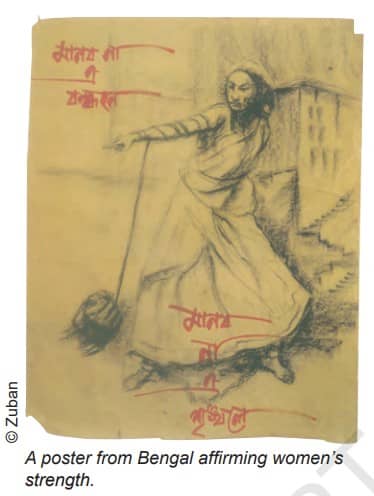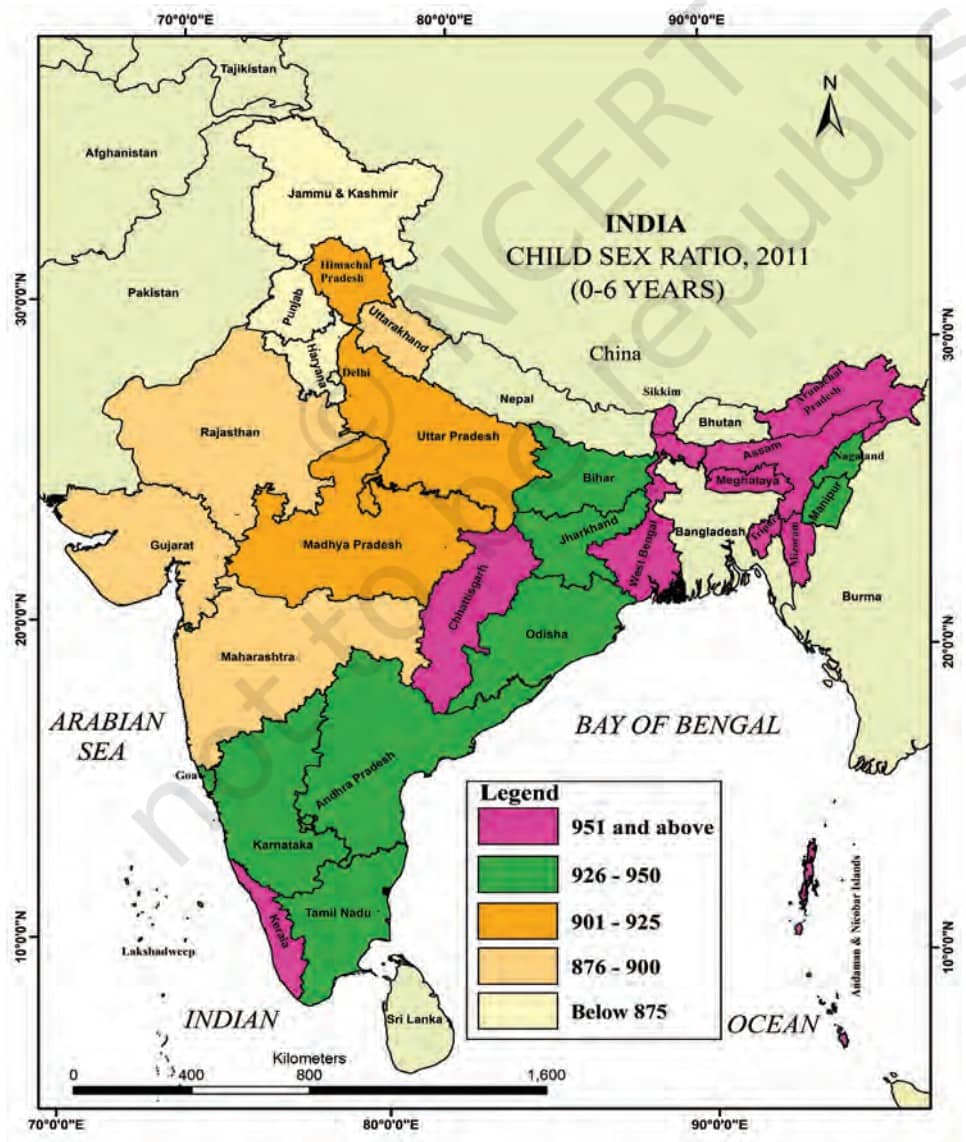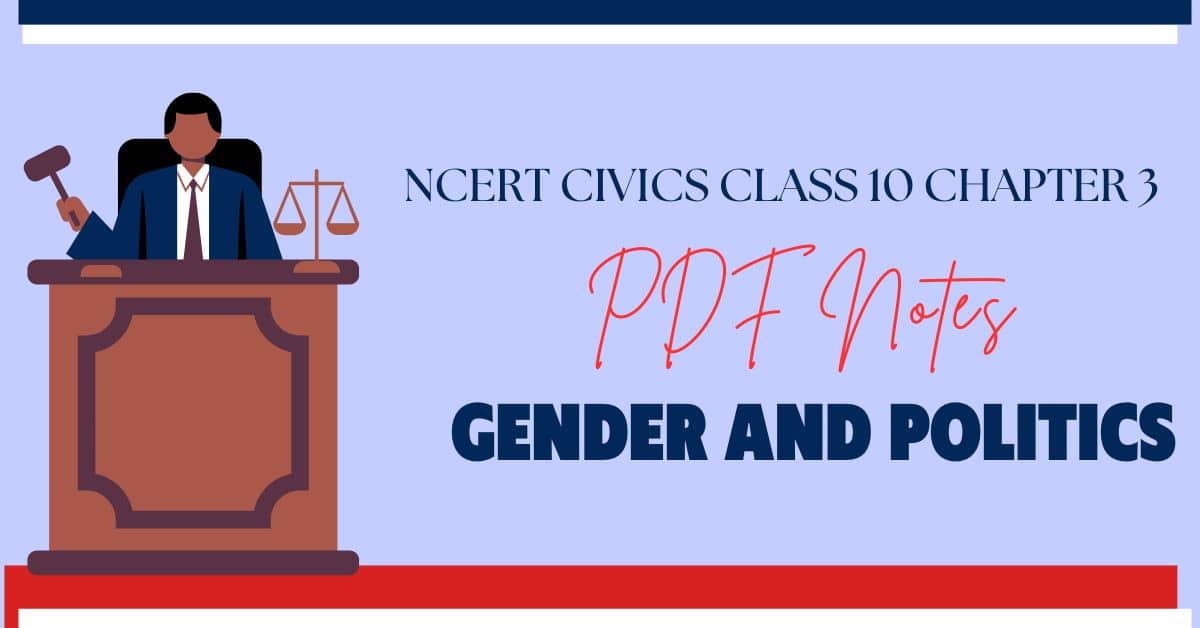Gender and Politics – Concept & Notes PDF
Topic & sub-topics covered: “Gender and Politics” and MCQs Questions: Gender, Religion and Caste (All single detail notes are exam-oriented).
We have discussed in-depth and exam-oriented pointers that can be asked in the board exam of class 10th about “Gender and Politics” from the NCERT Political Science (Civics) notes for class 10th chapter 3 “Gender, Religion and Caste“.
Download the NCERT Political Science (Civics) for Class 10 Chapter 3 Gender, Religion and Caste PDF Notes
Download the NCERT Political Science (Civics) for Class 10 Chapter 3 Gender, Religion and Caste PDF Notes to understand how social divisions impact politics in a democracy. These well-structured notes cover key concepts such as gender roles, religious differences, and caste-based inequalities. These notes are based on the latest CBSE syllabus, this notes are perfect for board exam and school exam preparation and concept understanding. Students can easily understand how democratic politics deals with diversity and promotes social justice. Get your free NCERT Civics Chapter 3 PDF notes today and start your Class 10 Political Science (Civics) preparation.
Gender and Politics

1. Definition of Gender Division:
- Gender division is a hierarchical social division present worldwide.
- It is rarely acknowledged in political studies.
2. Misconception About Gender Division:
- Often perceived as natural and unchangeable.
- Not based on biological factors but on social expectations and stereotypes.
3. Sexual Division of Labour:
- A system where women primarily manage household work.
- Work inside the home is either performed by women or organized by them through domestic helpers.
4. Gender Roles in Society:
- Society assigns specific roles to men and women based on stereotypes.
- This results in limited opportunities for women in public and political life.
5. Political Relevance of Gender Division:
- Gender-based inequalities influence social and economic policies.
- Recognizing gender division is crucial for achieving gender equality in politics.
Public/Private Division

1. Gender Stereotypes and Social Expectations:
- Boys and girls are socialized to believe that women’s primary role is housework and child-rearing.
- The sexual division of labour is deeply ingrained in society, where women handle household work, and men work outside.
2. Sexual Division of Labour:
- Women perform tasks like cooking, cleaning, tailoring, and childcare, while men engage in outside work.
- Men do not consider household chores their responsibility, but they take up such jobs when paid (e.g., male tailors and hotel cooks).
3. Women’s Economic Contribution:
- Women in villages fetch water, collect fuel, and work in fields.
- Urban poor women work as domestic helpers, while middle-class women have office jobs.
- Despite working inside and outside the home, women’s contributions are undervalued and unrecognized.
4. Limited Role of Women in Public and Political Life:
- Women make up half of the population but have minimal participation in public life, especially in politics.
- Historically, only men were allowed to vote and contest elections.
- Over time, the women’s rights movement fought for equal voting rights and political participation.
5. Feminist Movements and Their Impact:
- Feminist movements demanded equal political and legal status for women.
- They also advocated for better education and career opportunities.
- More radical feminist movements fought for equality in personal and family life.
6. Women’s Growing Role in Public Life:
- Political awareness and mobilization have improved women’s presence in various professions such as:
- Scientists, doctors, engineers, lawyers, managers, and educators.
- Scandinavian countries (Sweden, Norway, Finland) have high female participation in public life.
7. Gender Inequality in India:
- Despite progress since Independence, India remains a male-dominated, patriarchal society.
- Women face discrimination, oppression, and disadvantage in multiple areas.
8. Education and Gender Gap:
- Female literacy rate: 54% vs. Male literacy rate: 76%.
- Fewer girls pursue higher education as parents prioritize boys’ education.
- Despite performing well academically, many girls drop out due to societal and economic factors.
9. Gender Pay Gap and Economic Discrimination:
- Women work one hour more per day than men but their work is often unpaid and undervalued.
- The Equal Remuneration Act, of 1976 mandates equal pay for equal work, but women still earn less in fields like sports, cinema, factories, and agriculture.
10. Declining Child Sex Ratio and Gender Bias:
- Sex-selective abortions have led to a declining child-sex ratio (919 girls per 1000 boys).
- In some states, the ratio has fallen below 850 or even 800.
- The preference for male children continues to impact gender demographics negatively.
11. Violence and Harassment Against Women:
- Women face harassment, exploitation, and violence in various forms.
- Urban areas are unsafe, with increasing cases of abuse.
- Domestic violence is prevalent, and women are not safe even in their own homes.
12. Key Terms:
- Feminist: A person who advocates for equal rights and opportunities for men and women.
- Patriarchy: A system where men hold power over women, both in society and the family.
Women’s Political Representation

1. Lack of Attention to Women’s Issues:
- Despite widespread awareness, women’s well-being is not given priority in decision-making.
- Feminists and women’s movements believe that women must control power to ensure their issues receive adequate attention.
2. Low Representation of Women in Indian Politics:
- Women’s participation in legislatures is very low in India.
- In 2019, the proportion of women in the Lok Sabha reached 14.36% for the first time.
- Their representation in State Assemblies remains below 5%.
3. Global Comparison of Women’s Representation:
- India ranks low in women’s political representation compared to Africa and Latin America.
- Government cabinets are mostly male-dominated, even when a woman holds a key position like Chief Minister or Prime Minister.
4. Panchayati Raj and Women’s Reservation:
- To address gender disparity, one-third of seats in Panchayati Raj institutions (local bodies like panchayats and municipalities) are reserved for women.
- Over 10 lakh women are now elected representatives in rural and urban local bodies.
5. Women’s Reservation in Parliament and State Assemblies:
- Women’s organizations and activists have been demanding 33% reservation in Lok Sabha and State Assemblies for decades.
- The Nari Shakti Vandan Adhiniyam (Women’s Reservation Act, 2023) was passed, ensuring one-third reservation for women in:
a. Lok Sabha (Lower House of Parliament)
b. State Legislative Assemblies
c. Delhi Assembly
6. Political Expression of Social Divisions:
- Gender division, like other social divisions, must be expressed politically to bring about positive change.
- The political mobilization of disadvantaged groups, such as women, helps them secure rights and representation.
7. Importance of Political Representation for Women’s Progress:
- If women’s unequal treatment had not been raised in politics, progress in education, employment, and rights would have been much slower.
- The inclusion of women in politics ensures that gender-related concerns are addressed at the highest level.
Next & Previous Topics of NCERT/CBSE Political Science (Civics) Class 10 Chapter 3: Gender, Religion and Caste
| Topics No. | Topics Name |
|---|---|
| 1 | Gender and Politics |
| 2 | Religion, Communalism And Politics |
| 3 | Caste and Politics |
MCQs on NCERT Civics Class 10 Chapter 3 Tpoic – Gender and Politics
Here are top exam oriented mcq’s type questions on “Gender and Politics” that you should prepare for your CBSE or state board exams:
Question 1. What is gender division?
a) A biological difference between men and women
b) A natural and unchangeable division in society
c) A form of hierarchical social division based on social expectations and stereotypes
d) A division that exists only in politics
Answer: c) A form of hierarchical social division based on social expectations and stereotypes
Question 2. What does the term ‘sexual division of labour’ refer to?
a) Equal distribution of work between men and women
b) A system where all household work is done or managed by women
c) A situation where men perform household work
d) A law ensuring equal wages for men and women
Answer: b) A system where all household work is done or managed by women
Question 3. Which of the following statements best describes the ‘public/private division’?
a) A belief that men should work in public spaces and women should do housework
b) A system where men and women share household work equally
c) A legal rule that ensures equal job opportunities
d) A division between government and private sector jobs
Answer: a) A belief that men should work in public spaces and women should do housework
Question 4. Which of the following is NOT an example of gender division in society?
a) Women doing all household chores while men work outside
b) Men being paid more than women for the same work
c) Equal representation of men and women in politics
d) Parents preferring to educate sons over daughters
Answer: c) Equal representation of men and women in politics
Question 5. Which factor led to the political expression of gender division?
a) The belief that women should stay at home
b) The demand for equal rights by women
c) The reluctance of women to participate in public life
d) The refusal of men to work outside
Answer: b) The demand for equal rights by women
Question 6. What were the main demands of feminist movements?
a) Enhancing the political and legal status of women
b) Restricting women to household work
c) Reducing women’s participation in politics
d) Encouraging women to take up only traditional professions
Answer: a) Enhancing the political and legal status of women
Question 7. In which regions is women’s participation in public life the highest?
a) South Asia
b) Scandinavian countries (Sweden, Norway, Finland)
c) Middle Eastern countries
d) Latin America
Answer: b) Scandinavian countries (Sweden, Norway, Finland)
Question 8. What is the main goal of feminist movements?
a) To establish the superiority of women over men
b) To create an entirely separate political system for women
c) To achieve equality between men and women in all spheres of life
d) To restrict men from participating in politics
Answer: c) To achieve equality between men and women in all spheres of life
Question 9. Which of the following is NOT a form of discrimination faced by women in India?
a) Lower literacy rate compared to men
b) Equal wages for equal work
c) Preference for educating boys over girls
d) Harassment and violence against women
Answer: b) Equal wages for equal work
Question 10. What is the literacy rate among women in India compared to men?
a) 65% for women, 85% for men
b) 54% for women, 76% for men
c) 70% for women, 80% for men
d) 80% for women, 90% for men
Answer: b) 54% for women, 76% for men
Question 11. What is the main reason for the low percentage of girls in higher education?
a) Girls are not interested in studying
b) Girls do not perform well in school
c) Parents prefer to invest in their sons’ education
d) Girls are not allowed to attend schools
Answer: c) Parents prefer to invest in their sons’ education
Question 12. According to the Equal Remuneration Act of 1976, what does the law mandate?
a) Women should be paid less than men
b) Men should be paid twice as much as women
c) Equal wages for equal work regardless of gender
d) Only men can work in industries
Answer: c) Equal wages for equal work regardless of gender
Question 13. Which of the following contributes to the declining child sex ratio in India?
a) The high literacy rate of women
b) Sex-selective abortion
c) Women’s participation in the workforce
d) Equal representation of women in politics
Answer: b) Sex-selective abortion
Question 14. What percentage of seats in local government bodies are reserved for women in India?
a) 10%
b) 20%
c) 33%
d) 50%
Answer: c) 33%
Question 15. What percentage of women were elected to the Lok Sabha in 2019?
a) 5%
b) 10%
c) 14.36%
d) 25%
Answer: c) 14.36%
Question 16. What is the name of the law passed in 2023 that reserves 33% of seats for women in Lok Sabha and State Assemblies?
a) Women’s Empowerment Act
b) Equal Representation Act
c) Nari Shakti Vandan Adhiniyam
d) Gender Equality Act
Answer: c) Nari Shakti Vandan Adhiniyam
Question 17. Which of the following best describes patriarchy?
a) A system where women hold more power than men
b) A system where men dominate and hold power over women
c) A political movement led by women
d) A legal system ensuring equal rights for women
Answer: b) A system where men dominate and hold power over women
Question 18. What is one major reason for the low representation of women in legislatures?
a) Lack of interest in politics among women
b) Resistance from male-dominated political parties
c) Women are legally not allowed to contest elections
d) Women are not eligible to vote in India
Answer: b) Resistance from male-dominated political parties
Question 19. What is the significance of women’s representation in politics?
a) It ensures women’s issues are given priority in policymaking
b) It reduces men’s role in governance
c) It creates an entirely separate government for women
d) It ensures that only women make laws
Answer: a) It ensures women’s issues are given priority in policymaking
Question 20. Why is gender division considered a social rather than a biological division?
a) It is based on natural differences between men and women
b) It is created by society through stereotypes and social norms
c) It has existed since ancient times and cannot change
d) It is a political strategy used by governments
Answer: b) It is created by society through stereotypes and social norms

